University Library Space Renovation Based on the User Learning Experience in Two Wuhan Universities
Abstract
:1. Introduction
2. Principles of Library Space Renovation
3. Methods
3.1. Research Case Selection
3.2. Questionnaire Design
4. Results
4.1. Descriptive Statistics
4.2. Factor Analysis of the Questionnaire and Data Analysis of Survey Responses
4.3. Binary Logistic Regression Analysis
4.3.1. Frequency of Visits to the Library
4.3.2. Binary Logistic Regression Analysis of Length of Visits to the Library
5. Discussion
5.1. Major Findings
5.1.1. Seven Spatial Factors Affecting User Experience
- E1: Physical environment self-control
- E2: Physical environment comfort
- E3: Aesthetics of indoor space
- E4: Indoor acoustic comfort
- E5: Indoor space comfort
- E6: Flexibility in the use of interior space
- E7: Complete guidance and equipment
5.1.2. Influence of Spatial Factors on Frequency of Visits and Length of Time in the Library
5.2. Strengths and Limitations
6. Conclusions
Author Contributions
Funding
Institutional Review Board Statement
Informed Consent Statement
Data Availability Statement
Conflicts of Interest
Appendix A
- □
- Male
- □
- Female
- □
- Undergraduate student
- □
- Postgraduate student
- □
- Doctoral candidate
- □
- Faculty and researcher
- □
- Law, philosophy, and economics
- □
- Pedagogy, literature, and history
- □
- Science, engineering, agriculture, and medicine
- □
- Military science, management science, and art science
- □
- Every day
- □
- Weekly
- □
- Monthly
- □
- Quarterly
- □
- Basically not going
- □
- Others
- □
- Less than 30 minutes
- □
- 30 minutes to 1 hour
- □
- 1–3 hours
- □
- More than 3 hours
- □
- Others
- □
- Study alone
- □
- Complete group work
- □
- Borrow and return books
- □
- Endorsement, speech practice
- □
- Use electronic resources in the library for learning
- □
- Communication, interaction, and other social activities
- □
- Entertainment (watching movies, listening to music, playing games, etc.)
- □
- Others
| Evaluation Dimension | Evaluation Factor | Your Comments | ||||
| 1 | 2 | 3 | 4 | 5 | ||
| Strongly Unaffected | Somewhat Unaffected | Neither Affected or Unaffected | Somewhat Affected | Strongly Affected | ||
| Question 7. the elements influence your learning experience is | 7.1. High physical environment comfort (lighting, illumination, ventilation, room temperature, etc.) | |||||
| 7.2. Highly refined interior decoration (decorative materials, color matching, greenery arrangement, etc.) | ||||||
| 7.3. Library adjacent to dormitory and canteen | ||||||
| 7.4. The library is open continuously and for long hours | ||||||
| 7.5. High number of service facilities (storage space, Internet/power supply, printers, copiers, etc.) | ||||||
| 7.6. Sufficient supply of tables and chairs | ||||||
| 7.7. Diversified learning space types (individual, group, casual learning areas, etc.) | ||||||
| 7.8. Good learning atmosphere | ||||||
| Question 8. Physical environment | 8.1. There is sufficient natural lighting in the pavilion | |||||
| 8.2. Adequate artificial lighting in the pavilion | ||||||
| 8.3. Good ventilation in the pavilion | ||||||
| 8.4. The temperature inside the pavilion is suitable (warm in winter and cool in summer) | ||||||
| 8.5. There is a beautiful view outside the window | ||||||
| Question 9. Interior decoration | 9.1. The overall interior decoration is exquisite | |||||
| 9.2. Beautiful overall interior coloring | ||||||
| 9.3. Interior greenery is properly arranged | ||||||
| Question 10. Service facility availability | 10.1. There is sufficient storage space in the pavilion | |||||
| 10.2. Good Wi-Fi signal quality in the pavilion | ||||||
| 10.3. There is a sufficient number of power outlets in the pavilion | ||||||
| 10.4. Electronic equipment, such as for printing and copying, are available | ||||||
| 10.5. There are computer workstations in the pavilion | ||||||
| 10.6 Clear signage in the pavilion | ||||||
| 10.7. Drinks and light snacks are available in the pavilion | ||||||
| Question 11. Study in the reading room or study room of the library | 11.1. The learning space is open and transparent | |||||
| 11.2. Low background noise | ||||||
| 11.3. The furniture is comfortable and ergonomic | ||||||
| 11.4. The tables and chairs provide some visual shading | ||||||
| 11.5. I can perceive the learning behavior of others | ||||||
| Question 12. Study in the library’s personal study space (personal study bin, personal study room, etc.) | 12.1. Adjustable light level | |||||
| 12.2. Adjustable temperature level | ||||||
| 12.3. The acoustic environment is private enough | ||||||
| 12.4. Personal study space is visible from the outside line of sight | ||||||
| Question 13. Study in the library’s group study spaces (collaborative group discussion rooms, small seminar rooms, etc.) | 13.1. Adjustable light level | |||||
| 13.2. Adjustable temperature level | ||||||
| 13.3. The acoustic environment is sufficiently private | ||||||
| 13.4. Group study space is visible from the outside line of sight | ||||||
| 13.5. Space layout can be changed flexibly | ||||||
| 13.6. The furniture is light and flexible and can be moved | ||||||
| Question 14. Study in the library’s relaxed study area (lobby, atrium, cafe, etc.) | 14.1. The furniture is casual and comfortable | |||||
| 14.2. The furniture is lightweight, flexible, and movable | ||||||
| 14.3. Space provides opportunities for social interaction | ||||||
| 14.4. The space provides an atmosphere of mental relaxation | ||||||
- □
- Very dissatisfied
- □
- Somewhat dissatisfied
- □
- Neither satisfied nor dissatisfied
- □
- Somewhat satisfied
- □
- Very satisfied
References
- Liu, J. On the spatial reengineering of libraries. Libr. World. 2017, 5, 45–49. [Google Scholar]
- Massis, B. The user experience (UX) in libraries. Inf. Learn. Sci. 2018, 119, 241–244. [Google Scholar] [CrossRef]
- Liddle, D. Best value—The impact on libraries: Practical steps in demonstrating best value. Libr. Manag. 1999, 20, 206–214. [Google Scholar] [CrossRef]
- Zeivots, S.; Schuck, S. Needs and expectations of a new learning space: Research students’ perspectives. Australas. J. Educ. Technol. 2018, 34, 27–40. [Google Scholar] [CrossRef] [Green Version]
- Harrop, D.; Turpin, B. A study exploring learners’ informal learning space behaviors, attitudes, and preferences. New Rev. Acad. Librariansh. 2013, 19, 58–77. [Google Scholar] [CrossRef] [Green Version]
- Thorpe, A.; Lukes, R.; Bever, D.J.; He, Y. The impact of the academic library on student success: Connecting the dots. Libr. Acad. 2016, 16, 373–392. [Google Scholar] [CrossRef] [Green Version]
- Jamieson, P. Designing more effective on-campus teaching and learning spaces: A role for academic developers. Int. J. Acad. Dev. 2003, 8, 119–133. [Google Scholar] [CrossRef]
- Lam, E.W.M.; Chan, D.W.M.; Wong, I. The architecture of built pedagogy for active learning—A case study of a university campus in Hong Kong. Buildings 2019, 9, 230. [Google Scholar] [CrossRef] [Green Version]
- Thaler, M.; Burke-Vigeland, M.; Hickson, K.; Broz, D.; Anderson, A.; Barber, C. Why Do Students Really Go to the Library? 2014. Available online: http://www.gensler.com/design-thinking/research/future-of-the-academic-library (accessed on 17 March 2014).
- Gifford, R. Environmental Psychology: Principles and Practice, 5th ed.; Optimal Books: Colville, WA, USA, 2014. [Google Scholar]
- Venetjoki, N.; Kaarlela-Tuomaala, A.; Keskinen, E.; Hongisto, V. The effect of speech and speech intelligibility on task performance. Ergonomics 2006, 49, 1068–1091. [Google Scholar] [CrossRef]
- Samani, A.S. The impact of indoor lighting on students’ learning performance in learning environments: A knowledge internalization perspective. Int. J. Bus. Soc. Sci. 2012, 3, 127–136. [Google Scholar]
- Daisey, J.M.; Angell, W.J.; Apte, M.G. Indoor air quality, ventilation and health symptoms in schools: An analysis of existing information. Indoor Air 2003, 13, 53–64. [Google Scholar] [CrossRef]
- Mendell, M.J.; Heath, G.A. Do indoor pollutants and thermal conditions in schools influence student performance? A critical review of the literature. Indoor Air 2005, 15, 27–52. [Google Scholar] [CrossRef] [PubMed]
- Seppänen, O.; Fisk, W.J.; Faulkner, D. Cost Benefit Analysis of the Night-Time Ventilative Cooling in Office Building. In Proceedings of the 7th International Conference on Healthy Buildings, National University of Singapore, Singapore, 7–11 December 2013. [Google Scholar]
- Riddle, M.D.; Souter, K. Designing informal learning spaces using student perspectives. J. Learn. Spaces 2012, 1, 1–6. [Google Scholar]
- Lam, P.; Fox, B.; Ho, E. Informal Learning Space Study Report—1/F, Esther Lee Building; Working Paper 5; Centre for Learning Enhancement and Research, The Chinese University of Hong Kong: Hong Kong, China, 2009. [Google Scholar]
- Fisher, K.; Newton, C. Transforming the twenty-first-century campus to enhance the net-generation student learning experience: Using evidence-based design to determine what works and why in virtual/physical teaching spaces. High. Educ. Res. Dev. 2014, 33, 903–920. [Google Scholar] [CrossRef]
- Ramu, V.; Taib, N.; Massoomeh, H.M. Informal academic learning space preferences of tertiary education learners. J. Facil. Manag. 2021. ahead-of-print. [Google Scholar]
- Burn, K.; Cunningham, M.; Waller, L.; Walton, E.; Walton, G. Capturing the student user experience (UX) in York and Loughborough University Library buildings. Perform. Meas. Metrics 2016, 17, 175–187. [Google Scholar] [CrossRef] [Green Version]
- Earthman, G.; Lemasters, L. Review of Research on the Relationship between School Buildings, Student Achievement, and Student Behavior. In Proceedings of the International Annual Meeting of the Council of Educational Facilities Planners, Tarpon Springs, FL, USA, 8 October 1996. [Google Scholar]
- Shandrow, K.L. How the Color of Your Office Impacts Productivity (Infographic). Entrepreneur Asia Pacific 9 March 2015. Available online: https://www.entrepreneur.com/article/243749 (accessed on 3 October 2019).
- Bringslimark, T.; Hartig, T.; Patil, G. The psychological benefits of indoor plants: A critical review of the experimental literature. J. Environ. Psychol. 2009, 29, 422–433. [Google Scholar] [CrossRef]
- Andrews, C.; Wright, S.E.; Raskin, H. Library learning spaces: Investigating libraries and investing in student feedback. J. Libr. Adm. 2016, 56, 647–672. [Google Scholar] [CrossRef]
- Mairaj, M.I.; Naseer, M.M. Library services and user satisfaction in developing countries: A case study. Health Inf. Libr. J. 2013, 30, 318–326. [Google Scholar] [CrossRef]
- Freeman, G.T. The Library as Place: Changes in Learning Patterns, Collections, Technology, and Use. In Library as Place: Rethinking Roles, Rethinking Space, 1st ed.; Council on Library and Information Resources: Washington, DC, USA, 2005; pp. 1–9. Available online: http://www.clir.org/pubs/abstract/pub129abst.html (accessed on 5 December 2021).
- Foster, N.F.; Gibbons, S. (Eds.) Studying Students: The Undergraduate Research Project at the University of Rochester; Association of College and Research Libraries: Chicago, IL, USA, 2007. [Google Scholar]
- Gayton, J.T. Academic libraries: “Social” or “Communal?”. The nature and future of academic libraries. J. Acad. Librariansh. 2008, 34, 60–66. [Google Scholar] [CrossRef]
- Holder, S.; Lange, J. Looking and listening: A mixed-methods study of space use and user satisfaction. Evid. Based Libr. Inf. Pract. 2014, 9, 4–27. [Google Scholar] [CrossRef] [Green Version]
- Beckers, R.; van der Voordt, T.; Dewulf, G. Why do they study there? Diary research into students’ learning space choices in higher education. High. Educ. Res. Dev. 2016, 35, 142–157. [Google Scholar] [CrossRef]
- Mott, M.S.; Robinson, D.H.; Walden, A.; Burnette, J.; Rutherford, A.S. Illuminating the effects of dynamic lighting on student learning. SAGE Open 2012, 2, 1–9. [Google Scholar] [CrossRef]
- Hawkins, H. The Environment for Learning. In Guide for Planning Educational Facilities; Moore, D.P., Ed.; Council of Educational Facility Planners: Columbus, OH, USA, 1991; pp. 141–155. [Google Scholar]
- Gibbons, S. Why Do Students Want to Be in the Library If They Aren’t Using the Books? In Upstate New York Science Librarians Conference. 2010. Available online: https://surface.syr.edu/nyscilib/40/ (accessed on 15 February 2022).
- DeFrain, E.; Hong, M. Interiors, affect, and use: How does an academic library’s learning commons support students’ needs? Evid. Based Libr. Inf. Pract. 2020, 15, 42–68. [Google Scholar] [CrossRef]
- Lippincott, J.K. Linking the information commons to learning. In Learning Spaces; EDUCAUSE: Washington, DC, USA, 2006; Available online: https://www.educause.edu/research-and-publications/books/learning-spaces/chapter-7-linking-information-commons-learning (accessed on 2 November 2021).
- Taylor, S.S. Effects of studio space on teaching and learning: Preliminary findings from two case studies. Innov. High. Educ. 2009, 33, 217–228. [Google Scholar] [CrossRef]
- Mehrabian, A. Individual differences in stimulus screening and arousability. J. Pers. 1977, 45, 237–250. [Google Scholar] [CrossRef]
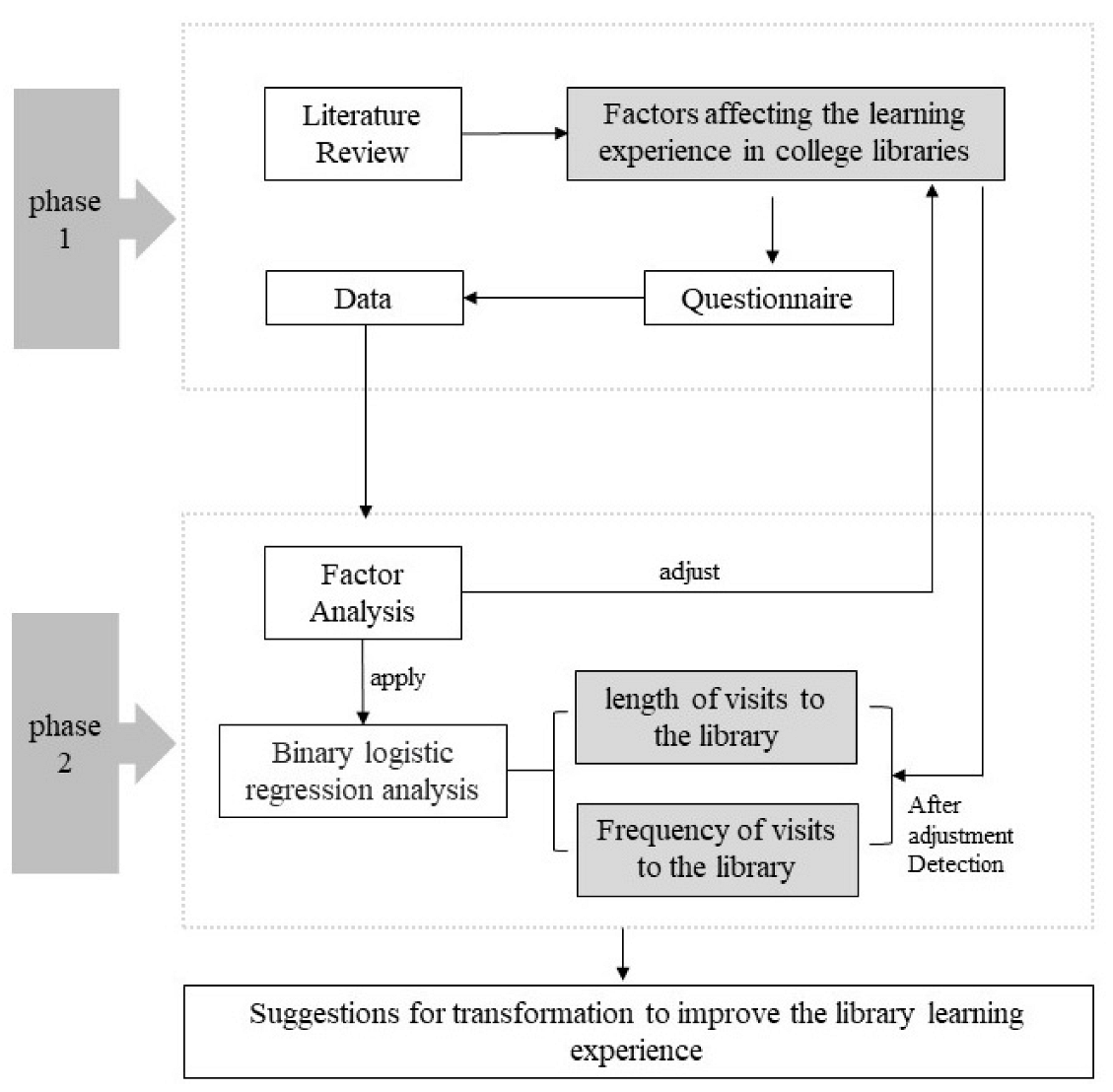
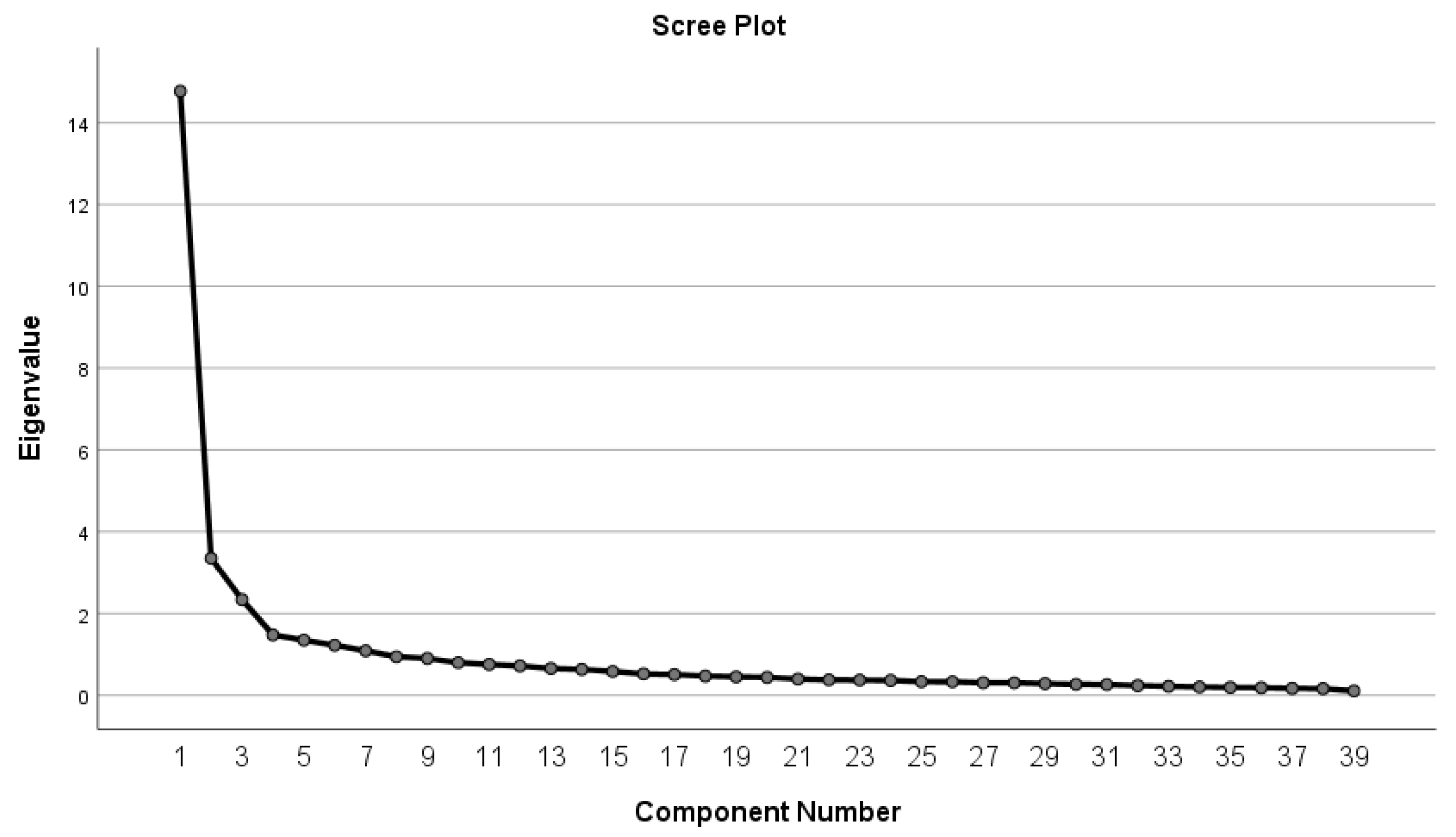
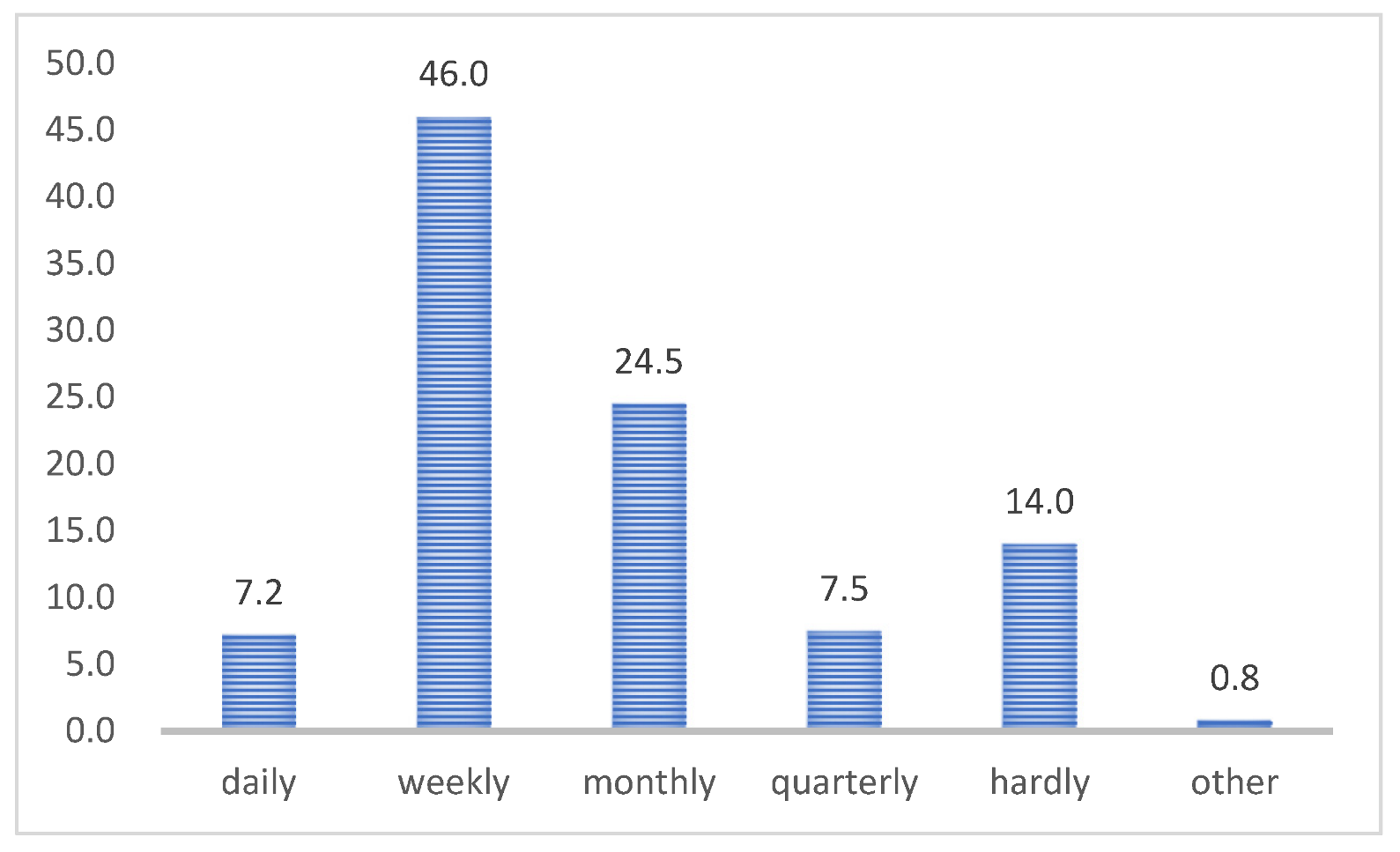
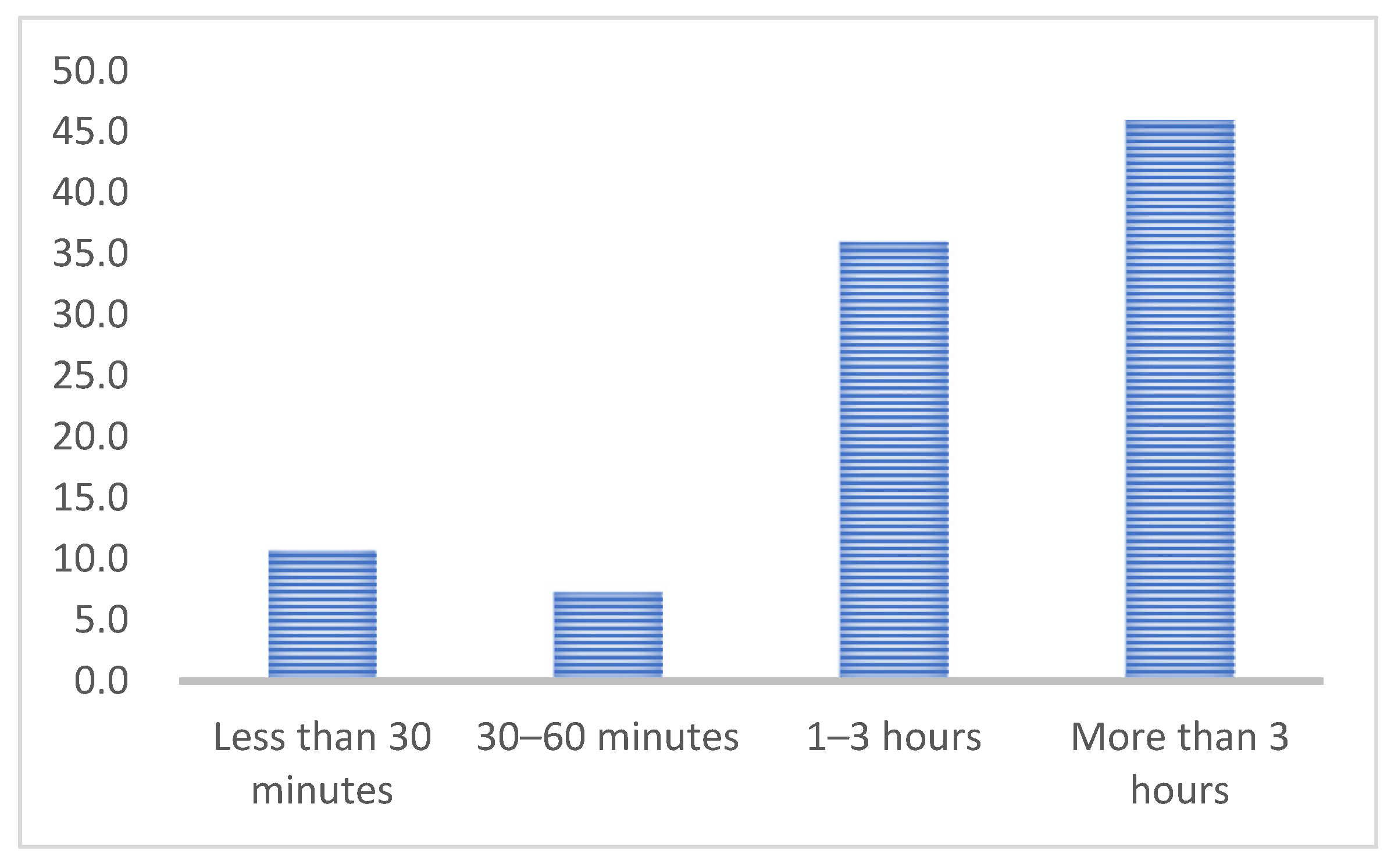
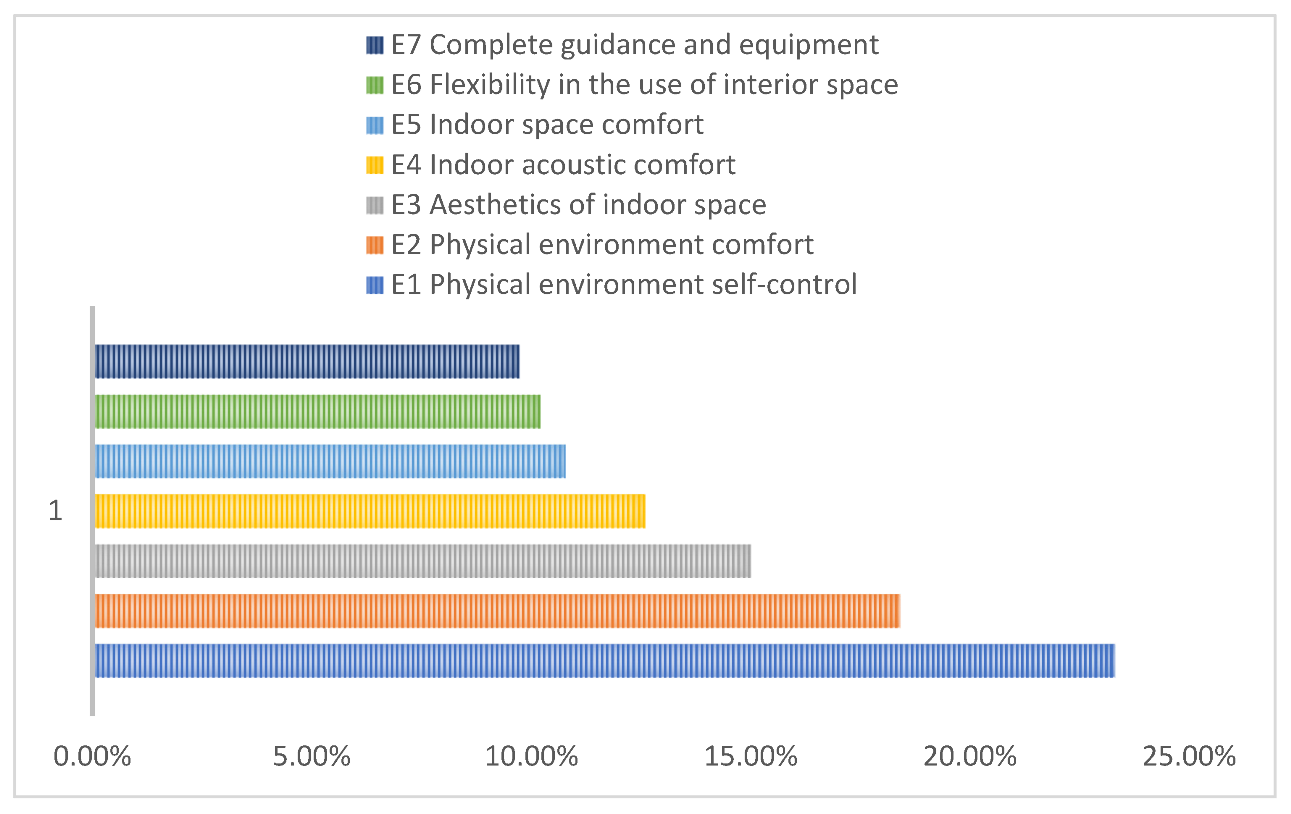
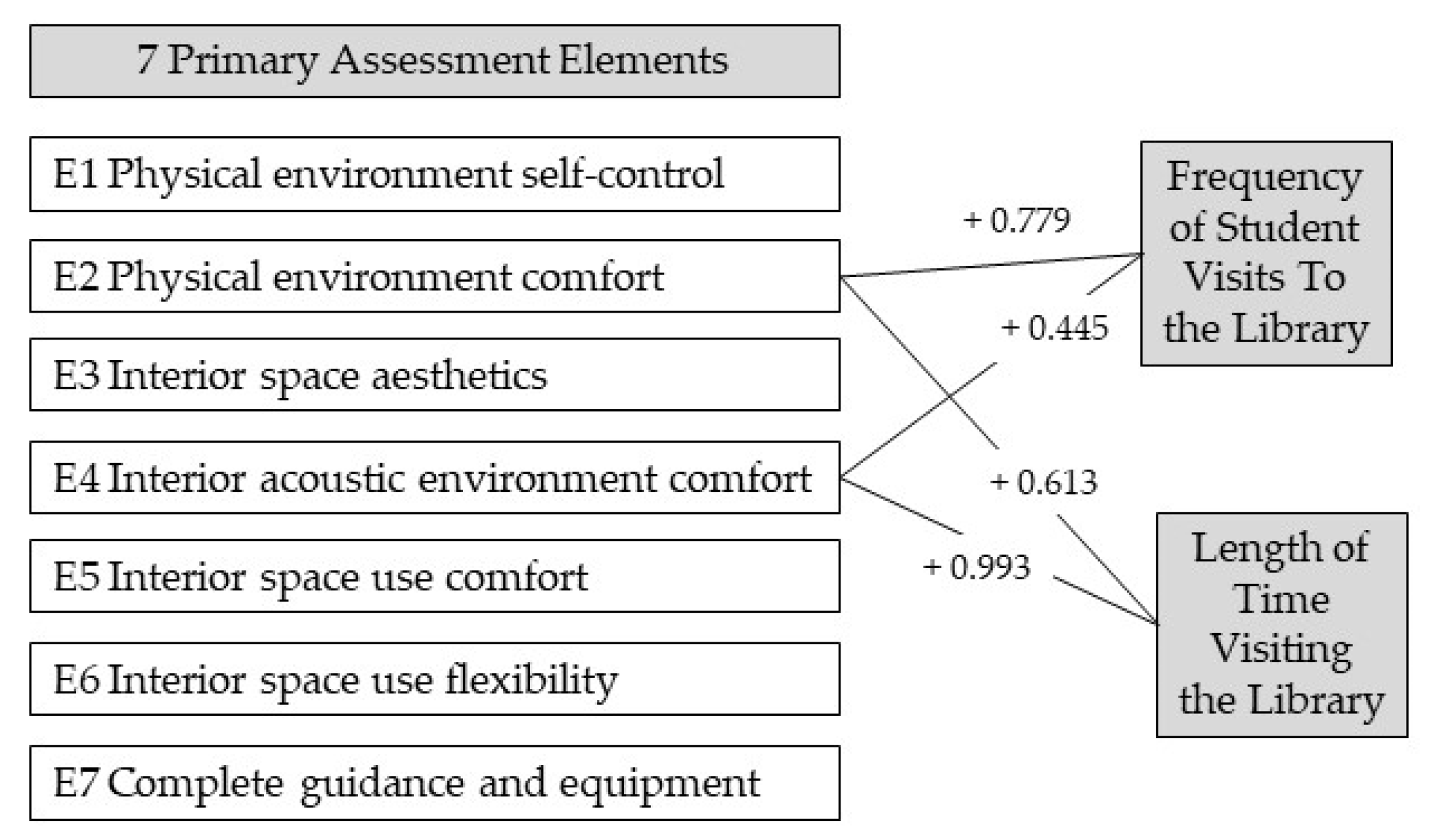
| Space Design Features | Sources |
|---|---|
| Sound; lighting (natural, artificial light); ventilation; temperature | [5,10,11,12,13,14,15] |
| Storage; power and outlet configurations; network and Wi-Fi quality; electronic equipment configurations such as printers, copiers, etc.; food availability; open hours; directional signage | [4,5,16,17,18,19] |
| Diversity of space types; individual study spaces; group discussion rooms | [5,20] |
| Decorative sophistication; colors; indoor greenery | [8,21,22,23] |
| Diversity of furniture types; home comfort; furniture flexibility | [24,25,26] |
| The geographically centralized location of the library | [27] |
| Primary Assessment Element | Secondary Assessment Element |
|---|---|
| a. Physical space environment | Interior acoustic environment |
| Interior lighting status (natural/artificial lighting) | |
| Interior ventilation status | |
| Interior temperature status | |
| b. Supporting facilities and services | Storage space |
| Amount of power supply and outlet configuration | |
| Quality of the network and Wi-Fi signal in the building | |
| Configuration of electronic equipment such as printers and copiers | |
| Light refreshment supply | |
| Library opening hours | |
| Guiding signs | |
| c. Space availability | Supply of tables and chairs for study and reading rooms |
| Supply of individual study rooms | |
| Supply of group seminar rooms | |
| Supply of open, collaborative spaces | |
| Supply of leisure study spaces | |
| Supply of diversified learning spaces | |
| d. Interior decoration | Interior decoration refinement |
| Interior decoration color aesthetics | |
| Interior greenery configuration | |
| e. Furniture type and comfort | Diversification of furniture types |
| Furniture comfort | |
| Furniture flexibility | |
| f. Space layout accessibility | Nearby residence |
| Library cafeteria |
| School Name | Basic Information | |||
|---|---|---|---|---|
| Site | Total Floor Area | Completion Date | Date of Expansion/Construction | |
| Wuhan University | Core area of the campus teaching area | 35,548 | 1981 | 2014 |
| Wuhan University of Technology | West of the teaching | 48,800 | 2016 | / |
| School Name | Partial Learning Space Distribution | Type of Learning Space | |||
|---|---|---|---|---|---|
| Reading or Study | Personal | Group | Leisure | ||
| Wuhan University |  |  |  |  |  |
| Wuhan University of Technology | 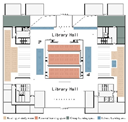 |  |  |  |  |
| Cronbach’s Alpha | Cronbach’s Alpha Based on Standardized Items | Number of Items |
|---|---|---|
| 0.950 | 0.954 | 42 |
| Item-Total Statistics | ||||
|---|---|---|---|---|
| Scale Mean If Item Deleted | Scale Variance If Item Deleted | Corrected Item-Total Correlation | Cronbach’s Alpha If Item Deleted | |
| Question 7.3. Library adjacent to dormitory and cafeteria | 163.46 | 546.305 | 0.354 | 0.950 |
| Question 12.4. Personal study space is visible from the outside line of sight | 164.00 | 543.909 | 0.381 | 0.950 |
| Question 13.4. Group study space is visible from the outside line of sight | 163.93 | 543.267 | 0.379 | 0.950 |
| Variable | Option | Frequency | Percent |
|---|---|---|---|
| Gender | Male | 232 | 54.2 |
| Female | 196 | 45.8 | |
| Degree | Undergraduate | 199 | 46.5 |
| Master’s | 186 | 43.5 | |
| Doctorate | 35 | 8.2 | |
| Faculty and Researchers | 7 | 1.6 | |
| Other | 1 | 0.2 | |
| Major | Philosophy, economics, law | 49 | 11.4 |
| Pedagogy, literature, history | 84 | 19.6 | |
| Science, engineering, agriculture, medicine | 246 | 57.5 | |
| Military science, management science, science of art | 49 | 11.4 |
| Variable | Option | Frequency | Percent |
|---|---|---|---|
| Frequency of visits to the library | Daily | 31 | 7.2 |
| Weekly | 197 | 46.0 | |
| Monthly | 105 | 24.5 | |
| Quarterly | 32 | 7.5 | |
| Hardly | 60 | 14.0 | |
| Others | 3 | 0.7 | |
| Length of visits to the library | Less than 30 min | 46 | 10.7 |
| 30–60 min | 31 | 7.2 | |
| 1–3 h | 154 | 36.0 | |
| More than 3 h | 197 | 46.0 |
| Variable | Option | Frequency | Percent | Percentage of Cases |
|---|---|---|---|---|
| The purpose of visiting the library | Study alone | 364 | 40.5% | 85.0% |
| Complete group work | 106 | 11.8% | 24.8% | |
| Borrow and return books | 187 | 20.8% | 43.7% | |
| Endorsement, speech practice | 40 | 4.4% | 9.3% | |
| Use electronic resources in the library | 114 | 12.7% | 26.6% | |
| Communication, interaction, and other social activities | 58 | 6.5% | 13.6% | |
| Entertainment (watching movies, listening to music, playing games, etc.) | 18 | 2.0% | 4.2% | |
| Others | 12 | 1.3% | 2.8% | |
| Total | 899 | 100.0% | 210.0% |
| KMO and Bartlett’s Test | ||
|---|---|---|
| Kaiser–Meyer–Olkin measure of sampling adequacy | 0.938 | |
| Bartlett’s test of sphericity | Approximate chi-square value | 10,996.908 |
| Degree of freedom (df) | 741 | |
| Significance level (p-value) | 0.000 | |
| Total Variance Explained | |||||||||
|---|---|---|---|---|---|---|---|---|---|
| Component | Initial Eigenvalues | Extraction Sums of Squared Loadings | Rotation Sums of Squared Loadings | ||||||
| Total | % of Variance | Cumulative % | Total | % of Variance | Cumulative % | Total | % of Variance | Cumulative % | |
| 1 | 14.771 | 37.875 | 37.875 | 14.771 | 37.875 | 37.875 | 5.963 | 15.289 | 15.289 |
| 2 | 3.348 | 8.584 | 46.459 | 3.348 | 8.584 | 46.459 | 4.708 | 12.073 | 27.362 |
| 3 | 2.340 | 5.999 | 52.457 | 2.340 | 5.999 | 52.457 | 3.840 | 9.846 | 37.207 |
| 4 | 1.474 | 3.779 | 56.236 | 1.474 | 3.779 | 56.236 | 3.221 | 8.260 | 45.468 |
| 5 | 1.346 | 3.451 | 59.687 | 1.346 | 3.451 | 59.687 | 2.756 | 7.065 | 52.533 |
| 6 | 1.222 | 3.134 | 62.821 | 1.222 | 3.134 | 62.821 | 2.609 | 6.691 | 59.224 |
| 7 | 1.087 | 2.788 | 65.608 | 1.087 | 2.788 | 65.608 | 2.490 | 6.385 | 65.608 |
| Rotated Component Matrix | |||||||
|---|---|---|---|---|---|---|---|
| Component | |||||||
| 1 | 2 | 3 | 4 | 5 | 6 | 7 | |
| Q13.1 | 0.854 | ||||||
| Q12.1 | 0.833 | ||||||
| Q12.2 | 0.778 | ||||||
| Q13.2 | 0.764 | ||||||
| Q14.1 | 0.654 | ||||||
| Q14.2 | 0.527 | ||||||
| Q11.1 | 0.523 | ||||||
| Q14.3 | 0.517 | ||||||
| Q7.7 | 0.701 | ||||||
| Q7.3 | 0.659 | ||||||
| Q8.2 | 0.656 | ||||||
| Q10.3 | 0.622 | ||||||
| Q8.4 | 0.621 | ||||||
| Q8.3 | 0.568 | ||||||
| Q10.1 | 0.547 | ||||||
| Q7.5 | 0.520 | ||||||
| Q10.2 | 0.518 | ||||||
| Q7.1 | |||||||
| Q9.3 | 0.812 | ||||||
| Q9.2 | 0.745 | ||||||
| Q8.5 | 0.731 | ||||||
| Q9.1 | 0.707 | ||||||
| Q8.1 | 0.509 | ||||||
| Q11.4 | |||||||
| Q12.3 | 0.660 | ||||||
| Q13.3 | 0.553 | ||||||
| Q11.3 | 0.530 | ||||||
| Q11.2 | 0.515 | ||||||
| Q14.4 | |||||||
| Q7.6 | 0.707 | ||||||
| Q7.4 | 0.596 | ||||||
| Q7.2 | 0.561 | ||||||
| Q10.7 | |||||||
| Q13.5 | 0.753 | ||||||
| Q13.4 | 0.721 | ||||||
| Q11.5 | 0.561 | ||||||
| Q10.5 | 0.775 | ||||||
| Q10.6 | 0.697 | ||||||
| Q10.4 | |||||||
| Primary Assessment Element | Secondary Assessment Element |
|---|---|
| Physical environment self-control | Adjustable light level |
| Adjustable temperature level | |
| Casual and comfortable furniture | |
| Furniture is lightweight, flexible, and movable | |
| Sight lines | |
| Space provides opportunities for social interaction | |
| Physical environment comfort | Good learning atmosphere |
| Library has continuous and long opening hours | |
| Sufficient artificial lighting in the library | |
| Sufficient power outlets in the library | |
| Temperature inside the library is suitable (warm in winter and cool in summer) | |
| Library has good ventilation | |
| Adequate storage space in the library | |
| Adequate supply of tables and chairs | |
| Good quality Wi-Fi signal in the building | |
| Interior space aesthetics | Interior greenery is properly arranged |
| Beautiful overall interior coloring | |
| Beautiful view outside the window | |
| Overall interior decoration is exquisite | |
| Ample natural light inside the building | |
| Interior acoustic environment comfort | Acoustic environment is sufficiently private |
| Low background noise | |
| Interior space use comfort | Various types of learning spaces |
| Abundant service facilities | |
| Interior space use flexibility | Layout of the space can be flexibly changed |
| Perceive the learning behavior of others | |
| Complete guidance and equipment | Computer workstations in the pavilion |
| Clear signage in the pavilion |
| Hosmer and Lemeshow Test | |||
|---|---|---|---|
| Step | Chi-Square | df | Sig. |
| 1 | 13.491 | 8 | 0.096 |
| 95% CI for Exp (B) | ||||||||
|---|---|---|---|---|---|---|---|---|
| B | S.E. | Wald | df | Sig. | Exp (B) | Lower | Upper | |
| E1 | −0.230 | 0.242 | 0.900 | 1 | 0.343 | 0.795 | 0.494 | 1.278 |
| E2 | 0.779 | 0.226 | 11.868 | 1 | 0.001 | 2.179 | 1.399 | 3.393 |
| E3 | −0.520 | 0.164 | 10.093 | 1 | 0.001 | 0.594 | 0.431 | 0.819 |
| E4 | 0.445 | 0.213 | 4.363 | 1 | 0.037 | 1.560 | 1.028 | 2.368 |
| E5 | −0.012 | 0.146 | 0.007 | 1 | 0.932 | 0.988 | 0.743 | 1.314 |
| E6 | −0.115 | 0.152 | 0.571 | 1 | 0.450 | 0.891 | 0.662 | 1.201 |
| E7 | 0.020 | 0.116 | 0.029 | 1 | 0.864 | 1.020 | 0.813 | 1.280 |
| Constant | −1.795 | 0.790 | 5.163 | 1 | 0.023 | 0.166 | ||
| Hosmer and Lemeshow Test | |||
|---|---|---|---|
| Step | Chi-Square | df | Sig. |
| 1 | 5.096 | 8 | 0.747 |
| 95% CI for Exp (B) | ||||||||
|---|---|---|---|---|---|---|---|---|
| B | S.E. | Wald | df | Sig. | Exp (B) | Lower | Upper | |
| E1 | 0.174 | 0.339 | 0.263 | 1 | 0.608 | 1.190 | 0.612 | 2.314 |
| E2 | 0.613 | 0.286 | 4.595 | 1 | 0.032 | 1.846 | 1.054 | 3.233 |
| E3 | −0.702 | 0.237 | 8.777 | 1 | 0.003 | 0.496 | 0.312 | 0.789 |
| E4 | 0.993 | 0.291 | 11.667 | 1 | 0.001 | 2.700 | 1.527 | 4.773 |
| E5 | 0.093 | 0.185 | 0.250 | 1 | 0.617 | 1.097 | 0.763 | 1.576 |
| E6 | −0.395 | 0.232 | 2.897 | 1 | 0.089 | 0.674 | 0.427 | 1.062 |
| E7 | −0.295 | 0.179 | 2.714 | 1 | 0.099 | 0.745 | 0.525 | 1.058 |
| Constant | −1.244 | 0.818 | 2.314 | 1 | 0.128 | 0.288 | ||
Publisher’s Note: MDPI stays neutral with regard to jurisdictional claims in published maps and institutional affiliations. |
© 2022 by the authors. Licensee MDPI, Basel, Switzerland. This article is an open access article distributed under the terms and conditions of the Creative Commons Attribution (CC BY) license (https://creativecommons.org/licenses/by/4.0/).
Share and Cite
Peng, L.; Wei, W.; Gong, Y.; Jia, R. University Library Space Renovation Based on the User Learning Experience in Two Wuhan Universities. Int. J. Environ. Res. Public Health 2022, 19, 10395. https://doi.org/10.3390/ijerph191610395
Peng L, Wei W, Gong Y, Jia R. University Library Space Renovation Based on the User Learning Experience in Two Wuhan Universities. International Journal of Environmental Research and Public Health. 2022; 19(16):10395. https://doi.org/10.3390/ijerph191610395
Chicago/Turabian StylePeng, Lei, Wenli Wei, Yichen Gong, and Ruiying Jia. 2022. "University Library Space Renovation Based on the User Learning Experience in Two Wuhan Universities" International Journal of Environmental Research and Public Health 19, no. 16: 10395. https://doi.org/10.3390/ijerph191610395
APA StylePeng, L., Wei, W., Gong, Y., & Jia, R. (2022). University Library Space Renovation Based on the User Learning Experience in Two Wuhan Universities. International Journal of Environmental Research and Public Health, 19(16), 10395. https://doi.org/10.3390/ijerph191610395








